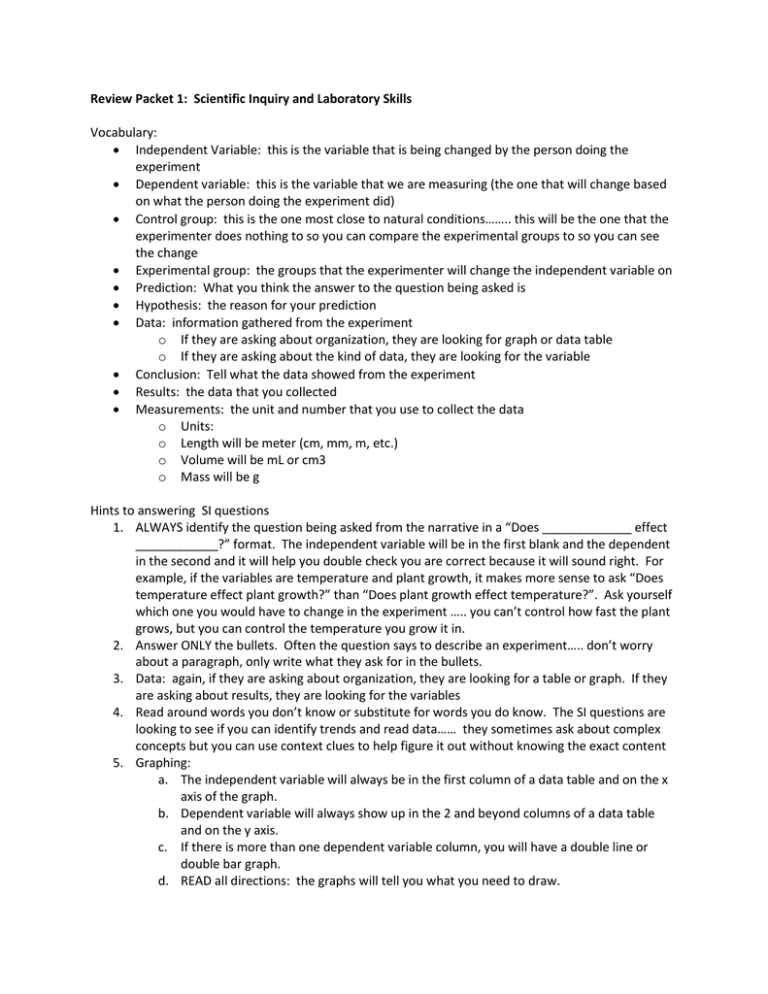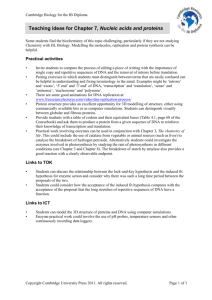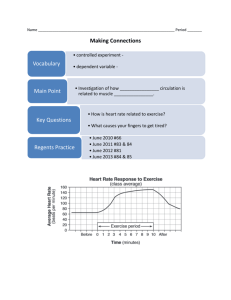Science Process Test Takers Review
advertisement

Review Packet 1: Scientific Inquiry and Laboratory Skills Vocabulary: Independent Variable: this is the variable that is being changed by the person doing the experiment Dependent variable: this is the variable that we are measuring (the one that will change based on what the person doing the experiment did) Control group: this is the one most close to natural conditions…….. this will be the one that the experimenter does nothing to so you can compare the experimental groups to so you can see the change Experimental group: the groups that the experimenter will change the independent variable on Prediction: What you think the answer to the question being asked is Hypothesis: the reason for your prediction Data: information gathered from the experiment o If they are asking about organization, they are looking for graph or data table o If they are asking about the kind of data, they are looking for the variable Conclusion: Tell what the data showed from the experiment Results: the data that you collected Measurements: the unit and number that you use to collect the data o Units: o Length will be meter (cm, mm, m, etc.) o Volume will be mL or cm3 o Mass will be g Hints to answering SI questions 1. ALWAYS identify the question being asked from the narrative in a “Does _____________ effect ____________?” format. The independent variable will be in the first blank and the dependent in the second and it will help you double check you are correct because it will sound right. For example, if the variables are temperature and plant growth, it makes more sense to ask “Does temperature effect plant growth?” than “Does plant growth effect temperature?”. Ask yourself which one you would have to change in the experiment ….. you can’t control how fast the plant grows, but you can control the temperature you grow it in. 2. Answer ONLY the bullets. Often the question says to describe an experiment….. don’t worry about a paragraph, only write what they ask for in the bullets. 3. Data: again, if they are asking about organization, they are looking for a table or graph. If they are asking about results, they are looking for the variables 4. Read around words you don’t know or substitute for words you do know. The SI questions are looking to see if you can identify trends and read data…… they sometimes ask about complex concepts but you can use context clues to help figure it out without knowing the exact content 5. Graphing: a. The independent variable will always be in the first column of a data table and on the x axis of the graph. b. Dependent variable will always show up in the 2 and beyond columns of a data table and on the y axis. c. If there is more than one dependent variable column, you will have a double line or double bar graph. d. READ all directions: the graphs will tell you what you need to draw. e. USE A SCALE!!!!! You CANNOT jus t take the numbers out of the data table and put them on the graph…… you need to count by a set amount of numbers (by 5’s or 10’s or 100’s) f. Label…. You lose points if it is not labeled 6. If you are asked about validity of an experiment or how you could make the experiment better ALWAYS say that you will increase the number of trials or you will increase the number of things in the experimental groups. This will ALWAYS be right no matter what the experiment is. Lab Techniques: 1. Gel Electrophoresis: putting DNA samples into a gel and running electricity through it to move the DNA….. small DNA moves the furthest from the wells and large DNA will be closer to the wells. Example: 2. Chromatography: separating colors on paper 3. Dissection: cutting open an animal to investigate what is inside it 4. Bacterial transformation: taking the DNA from an organism and putting it into a bacterial plasmid to make more copies of the desired protein/proteins quickly 5. Cloning: taking an egg cell from a host, placing the DNA from a parent cell into it (shocked back to before differentiation) and putting the egg into a host mother to develop 6. Staining: adding something to a slide (like iodine or bromothymol blue) to see cells better Technique below shows how to draw a stain without taking off the cover slip. Practice Questions: 1. A technique used to analyze pigments in spinach leaves is shown in the diagram below. This technique is known as (1) paper chromatography (2) gene manipulation (3) dissection (4) staining 2. A student performed an experiment to demonstrate that a plant needs chlorophyll for photosynthesis. He used plants that had green leaves with white areas. After exposing the plants to sunlight, he removed a leaf from each plant and processed the leaves to remove the chlorophyll. He then tested each leaf for the presence of starch. Starch was found in the area of the leaf that was green, and no starch was found in the area of the leaf that was white. He concluded that chlorophyll is necessary for photosynthesis. Which statement represents an assumption the student had to make in order to draw this conclusion? (1) Starch is synthesized from the glucose produced in the green areas of the leaf. (2) Starch is converted to chlorophyll in the green areas of the leaf. (3) The white areas of the leaf do not have cells. (4) The green areas of the leaf are heterotrophic. 3. In preparation for an electrophoresis procedure, enzymes are added to DNA in order to (1) convert the DNA into gel (2) cut the DNA into fragments (3) change the color of the DNA (4) produce longer sections of DNA 4. Paper chromatography is a laboratory technique that is used to (1) separate different molecules from one another (2) stain cell organelles (3) indicate the pH of a substance (4) compare relative cell sizes 5. A plant cell in a microscopic field of view is represented below The width (w) of this plant cell is closest to (1) 200 µm (2) 800 µm (3) 1200 µm (4) 1600 µm 6. A student conducted an experiment to determine if listening to different types of music would affect pulse rate. She thought that pulse rate would change with different types of music. Each person participating in her experiment listened to seven different selections of music for 30 seconds each. The pulse rates were taken after each 30-second interval of music. Based on her experiment, the student concluded that a person’s pulse rate changed when listening to different types of music. The component missing from this experiment is a (1) prediction (2) hypothesis (3) control group (4) research plan 7. An experiment was carried out to determine whether drinking caffeinated soda increases pulse rate. The pulse rates of two groups of people at rest were measured. Group A was then given caffeinated soda and group B was given caffeine-free soda. One hour after drinking the soda, the pulse rates were measured. The participants in the experiment were all the same age, and they were all given the same amount of soda. The dependent variable in this experiment is the (1) type of soda given to each group (2) amount of soda given to each group (3) pulse rate of each group (4) age of participants in each group 8. A student states that exercise will affect the number of times a person can squeeze a clothespin in a certain amount of time. An experiment is carried out to test this hypothesis. One group of ten students sits quietly before squeezing a clothespin as many times as possible during a one-minute interval. A second group of ten students does 25 jumping jacks before squeezing a clothespin as many times as possible during a one-minute interval. State one way the experiment could be improved in order to increase the validity of the results. [1] _______________________________________________________________________ _______________________________________________________________________ Base your answer to question 9 on the information below and on your knowledge of biology. Help for Aging Memories As aging occurs, the ability to form memories begins to decrease. Research has shown that an increase in the production of a certain molecule, BDNF, seems to restore the processes involved in storing memories. BDNF is found in the central nervous system and seems to be important in maintaining nerve cell health. Researchers are testing a new drug that seems to increase the production of BDNF. 9. Design an experiment to test the effectiveness of the new drug to increase the production of BDNF in the brains of rats. In your answer, be sure to: • state the hypothesis your experiment will test [1] • describe how the control group will be treated differently from the experimental group [1] • identify two factors that must be kept the same in both the experimental and control groups [1] • identify the dependent variable in your experiment [1] _______________________________________________________________________ _______________________________________________________________________ _______________________________________________________________________ _______________________________________________________________________ _______________________________________________________________________ _______________________________________________________________________ _______________________________________________________________________ _______________________________________________________________________ Base your answers to questions 10 through 13 on the information and data table below and on your knowledge of biology. An investigation was carried out over a five-year period to measure the effect of color on the survival of trout in a stream. The stream contained many brightly colored stones and food was plentiful. At the start of the investigation (year 0), 100 bright-colored trout and 100 drab-colored trout were placed into a section of the stream that had been blocked with netting. Investigators monitored the trout populations for five years and recorded the water condition each time a count was done. The data collected are shown in the table below. Directions (10-13): Using the information in the data table, construct a line graph on the grid on the following page, following the directions below. 10. Mark an appropriate scale on each labeled axis. [1] 11. Plot the data for the bright-colored trout on the grid. Surround each point with a small circle and connect the points. [1] 12. Plot the data for the drab-colored trout on the grid. Surround each point with a small triangle and connect the points. [1] Years 13. Explain how trout survival is related to the color of trout and the environmental condition of the stream. [1] _______________________________________________________________________ _______________________________________________________________________ 14. A student, using a metric ruler, measured a larva as represented in the diagram below. What is the length of the larva, in millimeters? [1] _____________________ mm 15. Plants respond to their environment in many different ways. Design an experiment to test the effects of one environmental factor, chosen from the list below, on plant growth. Acidity of precipitation Temperature Amount of water In your answer, be sure to: • identify the environmental factor you chose • state one hypothesis the experiment would test [1] • state how the control group would be treated differently from the experimental group [1] • state two factors that must be kept the same in both the experimental and control groups [1] • identify the independent variable in the experiment [1] • label the columns on the data table below for the collection of data in your experiment [1] Environmental factor: __________________________________ _______________________________________________________________________ _______________________________________________________________________ _______________________________________________________________________ _______________________________________________________________________ _______________________________________________________________________ _______________________________________________________________________ _______________________________________________________________________ _______________________________________________________________________ _______________________________________________________________________ _______________________________________________________________________ 16. Many plants can affect the growth of other plants near them. This can occur when one plant produces a chemical that affects another plant. Design an experiment to determine if a solution containing ground-up goldenrod plants has an effect on the growth of radish seedlings. In your experimental design be sure to: • state a hypothesis to be tested [1] • describe how the experimental group will be treated differently from the control group [1] • explain why the number of seedlings used for the experiment should be large [ 1] • identify the type of data that will be collected [1] • describe experimental results that would support your hypothesis [1] _______________________________________________________________________ _______________________________________________________________________ _______________________________________________________________________ _______________________________________________________________________ _______________________________________________________________________ _______________________________________________________________________ _______________________________________________________________________ _______________________________________________________________________ _______________________________________________________________________ _______________________________________________________________________ _______________________________________________________________________ _______________________________________________________________________ _______________________________________________________________________



